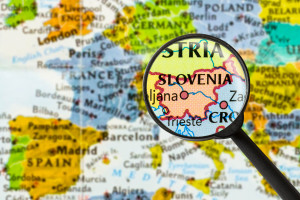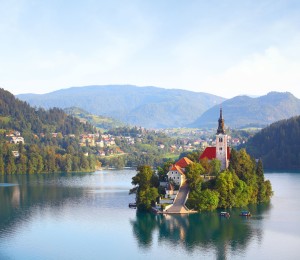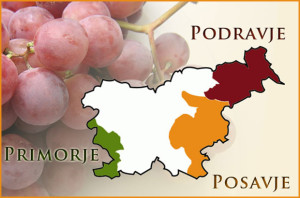Slovenia (officially the Republic of Slovenia) is a small European country with a long history of wine production. Its location on the Mediterranean coast and sharing a border with four established wineproducing countries (Italy to the west, Austria to the north, Croatia to the south and southeast, and Hungary to the northeast), places it at the crossroads of Europe’s wine culture.
Slovenia has been an independent nation since 1991 and a member of the European Union since 2004. PDO wines are categorized as zaščiteno označbo porekla (ZOP). There are currently 14 defined ZOP designations, as well as several variations within the ZOPs, such as those for Traditional Method sparkling wines, botrytis-affected wines, and wines with a certain degree of aging.
The 14 ZOPs are contained within the country’s three designated PGI wine regions, known in the Slovenian language as zaščiteno geografsko označbo (ZGO). These three regions are:
- Podravje: The Podravje ZGO is located in the inland east of the country, surrounding the valleys of the Pesnica, Drava, and Mura Rivers. This is the largest of the three regions, producing roughly half of the country’s wine.
- Primorska: The Primorska ZGO is located on the coast, across the Adriatic Sea from Venice and sharing a border with Italy’s Friuli region. Several of the wine areas located within Primorska straddle the Italian-Slovenian border, divided only by politics; Slovenia’s Goriška Brda ZOP becomes Italy’s Collio Goriziano DOC across the Italian border, and Slovenia’s Kras ZOP becomes Italy’s Carso DOC.
- Posavje: The Posavje ZGO is located in the southeast of Slovenia, along the border with Croatia. The name Posavje (Lower Sava) refers to its proximity to the end of the Sava River valley. This is the country’s smallest–and perhaps most old-fashioned–wine-producing region.
Grape varieties grown in Slovenia reflect the influence of Italy, Germany, and Austria, and include French (international) varieties as well. White wines are the leading product here; widely planted white grapes include Riesling, Gewürztraminer (Traminec), Müller-Thurgau (Rizvanec), Pinot Gris (Sivi Pinot), Sauvignon Blanc, and Chardonnay. White grapes popular in Friuli such as Tai (Friuliano) and Ribolla Gialla are grown primarily in Primorska, near the Italian border. Leading red grape varieties include Cabernet Sauvignon, Merlot, St. Laurent, Pinot Noir (known as Modri Pinot), and Refosco.
New material covering the wines of Slovenia is included in the 2017 Certified Specialist of Wine Study Guide, which is now available and being shipped from SWE’s home office! Other topics new to the 2017 guide include the wines of Bulgaria, Corsica, and Asia—as well as updated materials on all of the major wine-producing regions of the world.
References/for more information:
- Robinson, Jancis, Julia Harding and José Vouillamoz: Wine Grapes. New York, 2012: Harper Collins Publishers
- Robinson, Jancis and Julia Harding: The Oxford Companion to Wine, 4th Edition. Oxford, 2015: The Oxford University Press
- http://www.slovenianpremiumwines.com/
- https://www.bluedanubewine.com/regions/slovenia/


